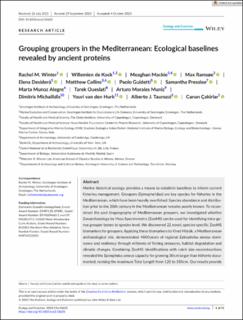| dc.contributor.author | Winter, Rachel M. | |
| dc.contributor.author | de Kock, Willemien | |
| dc.contributor.author | Mackie, Meaghan | |
| dc.contributor.author | Ramsøe, Max | |
| dc.contributor.author | Desiderà, Elena | |
| dc.contributor.author | Collins, Matthew | |
| dc.contributor.author | Guidetti, Paolo | |
| dc.contributor.author | Presslee, Samantha | |
| dc.contributor.author | Alegre, Marta Munoz | |
| dc.contributor.author | Oueslati, Tarek | |
| dc.contributor.author | Muniz, Arturo Morales | |
| dc.contributor.author | Michailidis, Dimitris | |
| dc.contributor.author | van den Hurk, Youri | |
| dc.contributor.author | Taurozzi, Alberto J. | |
| dc.contributor.author | Çakirlar, Canan | |
| dc.date.accessioned | 2024-01-23T10:29:07Z | |
| dc.date.available | 2024-01-23T10:29:07Z | |
| dc.date.created | 2023-11-03T12:43:40Z | |
| dc.date.issued | 2023 | |
| dc.identifier.issn | 2045-7758 | |
| dc.identifier.uri | https://hdl.handle.net/11250/3113295 | |
| dc.description.abstract | Marine historical ecology provides a means to establish baselines to inform current fisheries management. Groupers (Epinephelidae) are key species for fisheries in the Mediterranean, which have been heavily overfished. Species abundance and distribution prior to the 20th century in the Mediterranean remains poorly known. To reconstruct the past biogeography of Mediterranean groupers, we investigated whether Zooarchaeology by Mass Spectrometry (ZooMS) can be used for identifying intra-genus grouper bones to species level. We discovered 22 novel, species-specific ZooMS biomarkers for groupers. Applying these biomarkers to Kinet Höyük, a Mediterranean archaeological site, demonstrated 4000 years of regional Epinephelus aeneus dominance and resiliency through millennia of fishing pressures, habitat degradation and climatic changes. Combining ZooMS identifications with catch size reconstructions revealed the Epinephelus aeneus capacity for growing 30 cm larger than hitherto documented, revising the maximum Total Length from 120 to 150 cm. Our results provide ecological baselines for a key Mediterranean fishery which could be leveraged to define and assess conservation targets. | en_US |
| dc.language.iso | eng | en_US |
| dc.publisher | John Wiley & Sons Ltd. | en_US |
| dc.rights | Navngivelse 4.0 Internasjonal | * |
| dc.rights.uri | http://creativecommons.org/licenses/by/4.0/deed.no | * |
| dc.title | Grouping groupers in the Mediterranean: Ecological baselines revealed by ancient proteins | en_US |
| dc.title.alternative | Grouping groupers in the Mediterranean: Ecological baselines revealed by ancient proteins | en_US |
| dc.type | Peer reviewed | en_US |
| dc.type | Journal article | en_US |
| dc.description.version | publishedVersion | en_US |
| dc.source.volume | 13 | en_US |
| dc.source.journal | Ecology and Evolution | en_US |
| dc.source.issue | 10 | en_US |
| dc.identifier.doi | 10.1002/ece3.10625 | |
| dc.identifier.cristin | 2191895 | |
| dc.source.articlenumber | e10625 | en_US |
| cristin.ispublished | true | |
| cristin.fulltext | original | |
| cristin.qualitycode | 1 | |

